Microsoft published a new patentthat describes a method to reduce the memory footprint ofray-tracing graphics; directly addressing concerns surrounding the increasingly large memory requirements ray-tracing (andpath-tracing) requires. The technology described in the patent utilizes an aggressive level of detail (LOD) philosophy to improve or reduce ray-tracing quality as needed.
The patent describes the ray-tracing pipeline as an acceleration structure that can be optimized with a level of detail system. This is achieved through a residency map corresponding to a bounding volume hierarchy of objects. The graphics processing system is then able to use this map to determine what quality level objects need to be at the appropriate time.

To de-complicate this, Microsoft’s patent is proposing a design philosophy that video games already use within 3D environments. If you play first-person or 3rd person video games, you will know that at certain distances, terrain quality and texture quality will diminish the further you look ahead of your character. This is a cost-saving measure to boost performance by cutting back image quality in areas where it is less noticeable or not needed.
In the context of the patent, this LOD system would be applied to the ray-tracing pipeline instead and reduce its overall memory footprint.

This is potentially a fantastic optimization, that could have serious memory-saving (and performance-enhancing) implications in the future. Apparently, today’s ray-tracing design philosophy does not have a level of detail system that can boost or reduce ray-tracing quality on the fly, making scenes expensive to render on the storage side of things. (We already know that ray tracing is seriously demanding on the GPU side.)
Technically, current RT implementations get around this by heavily utilizing upscaling technologies such asDLSS,FSR,XeSS, or checkerboarding (console upscaling) to hide the performance penalty ray tracing has. However, having a dedicated LOD system for the ray tracing pipeline independent of render resolution will give developers a lot more flexibility on how performance can be optimized.
In real-world terms, this system should make VRAM-limited graphics cards more viable in modern ray tracing games. In particular, this could help 8GB and 10GB GPUs achieve smoother frame pacing with RT enabled in games where those VRAM capacities bottleneck performance. Potentially, Microsoft’s patented solution could also make ray-tracing more playable on 6GB and even 4GB (i.e.mobile RTX 3050) Nvidia GPUs that sport hardware-accelerated RT capabilities. This system could also help consoles like thePlayStation 5achieve more playable ray-tracing performance in memory-constrained environments. Despite it having 16GB of memory, only around 12GB is accessible by games.
Get Tom’s Hardware’s best news and in-depth reviews, straight to your inbox.
Aaron Klotz is a contributing writer for Tom’s Hardware, covering news related to computer hardware such as CPUs, and graphics cards.